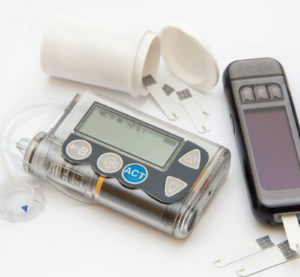 Dear Q&A
Dear Q&A
 Over the last decade, patients with insulin-requiring diabetes are increasingly using continuous subcutaneous insulin infusion (CSII) pumps. These pumps fundamentally provide continuous insulin to meet basal requirements with the ability to manually bolus additional insulin. Increasing sophistication has added continuous subcutaneous glucose monitoring (CGM) and insulin delivery driven by CGM (e.g., Minimed™ 670G, Medtronic, Northridge, CA). CSII pumps are commonly used in the perioperative period to provide insulin therapy based upon institutional guidelines.1,2 In a recent literature search, one published criterion to guide utilization of more sophisticated devices and automated features was found.3 Long et al. suggested that the pump should run intraoperatively. States with altered perfusion, shock, hypothermia, technical problems, and very high or low glucose values are determinants for discontinuing the device.3
Over the last decade, patients with insulin-requiring diabetes are increasingly using continuous subcutaneous insulin infusion (CSII) pumps. These pumps fundamentally provide continuous insulin to meet basal requirements with the ability to manually bolus additional insulin. Increasing sophistication has added continuous subcutaneous glucose monitoring (CGM) and insulin delivery driven by CGM (e.g., Minimed™ 670G, Medtronic, Northridge, CA). CSII pumps are commonly used in the perioperative period to provide insulin therapy based upon institutional guidelines.1,2 In a recent literature search, one published criterion to guide utilization of more sophisticated devices and automated features was found.3 Long et al. suggested that the pump should run intraoperatively. States with altered perfusion, shock, hypothermia, technical problems, and very high or low glucose values are determinants for discontinuing the device.3
The Minimed™ 670G is a hybrid closed loop system (HCLS). In the AutoMode, the pump uses CGM to automatically adjust basal and correctional insulin delivery while the patient manually selects prandial boluses. Patients can disable the AutoMode in temporary favor of Manual Mode. (In the Manual Mode, pre-programmed continuous basal insulin delivery remains, but both the prandial and correctional insulin boluses are calculated and acknowledged first by the patient). Although this hybrid closed loop system has been applauded as a huge technology advance, there are challenges to using it. Goodwin found that over one-third of the 83 patients studied abandoned use of the 670G due to “calibration requirements, problems with sensor durability or adhesion, skin irritation, and forced exits from AutoMode.”4
In AutoMode, near continuous interstitial glucose readings (every 5 minutes) automatically alter insulin delivery toward a pre-programmed blood glucose target. This automated functionality raises questions about its safety in the anesthetized patient.
- Is the AutoMode able to more precisely mitigate or correct for blood glucose derangements than an anesthesia professional who adheres to institutional guidelines on perioperative insulin pump management?
- Can AutoMode better abate surgical stress hyperglycemia?
- Is there an increased likelihood that anesthesia professionals must identify and respond to device alarms?
- Is special training required if anesthesia professionals are to use these pumps safely?
- How reliable is CGM technology? CGM interstitial values lag behind blood glucose values. Some CGMs lose accuracy with certain medications, including acetaminophen. CGMs are not recommended for decision-making in the inpatient setting.5
Hybrid closed-loop systems are a new rapidly developing technology with little in the literature to guide their perioperative use. Indeed, it is quite possible that some surgeries are being performed in AutoMode without the knowledge of the anesthesia professional. With a high glucose result, the anesthesia professional may bolus a correctional subcutaneous or IV insulin dose via syringe, while at the same time the AutoMode has increased insulin delivery via the insulin pump.
I realize that an hourly point-of-care blood glucose measurement is a key safety factor when caring for a patient receiving insulin therapy while anesthetized. With HCLS technology likely to proliferate, it would be helpful to have recommendations on the use of AutoMode and similar automatic modalities in the perioperative period for inclusion in our institution’s Perioperative Insulin Pump Guidelines.
Thank you for your time.
Tamra Dukatz, MSN, CRNA
Beaumont Health, Royal Oak, Michigan
Ms. Dukatz has received an investigator initiated grant from Sanofi, US, for her co-authored work entitled “Insulin glargine dosing before next-day surgery: comparing three strategies.” Journal of Clinical Anesthesia. 2012; 24: 610–617.
References
- Sobel SI, Augustine M, Donihi AC, et al. Safety and efficacy of a perio-operative protocol for patients with diabetes treated with continuous subcutaneous insulin infusion who are admitted for same-day surgery. Endocrine Practice. 2015;21:1269–76.
- Rotruck S, Suszan L, Vigersky R, et al. Should continuous subcutaneous insulin infusion (CSII) pumps be used during the perioperative period? Development of a clinical decision algorithm. AANA Journal. 2018;86:194–200.
- Long MT, Coursin, DB, Rice MJ. Perioperative considerations for evolving artificial pancreas device. Anesthesia & Analgesia. 2019;128:902–6.
- Goodwin G, et al. Challenges in implementing hybrid closed loop insulin pump therapy (medtronic 670g) in a ‘real-world’ clinical setting. ENDO 2019; Abstract OR14-5 Journal of the Endocrine Society, Volume 3, Issue Supplement_1, April–May 2019, https://doi.org/10.1210/js.2019-OR14-5
- Umpierrez GE, Klonoff, DC. Diabetes technology update: use of insulin pumps and continuous glucose monitoring in the hospital. Diabetes Care. 2018;41:1579–89. https://doi.org/10.2337/dci18-0002
 Response:
Response:
Increasing numbers of patients are using insulin pumps and require anesthetic care, and therefore, the concerns raised by the author above in her letter are timely and worthy of consideration. The growth in adopting continuous subcutaneous insulin infusion (CSII) technology is a testament to the added convenience and quality of glucose control this technology affords patients. These advantages can be just as useful in the perioperative period as they are in the outpatient setting. With improvements and advances in pump technology, including the hybrid closed-loop system (HCLS), glucose management is transitioning from an active responsibility of the anesthesia professional to a (semi-)automated process.1
Before addressing specific questions about HCLS for glucose management, it is worthwhile to consider the benefits of maintaining CSII in the perioperative setting as compared to provider-managed glucose control. CSII-controlled insulin at a basal rate is personalized to provide the closest possible physiologic replacement for the patient’s nonfunctional pancreas. Although it is yet to be studied scientifically, switching to a previously untested empiric strategy abruptly prior to surgery is intuitively less ideal than continuing the method or technique that has been optimized for the patient.
Furthermore, insulin pumps can deliver doses of insulin with a precision of 0.1, or even 0.05 units. This degree of precision cannot be achieved by providers. Administering intraoperative insulin boluses for hyperglycemia via the pump is the optimal way to administer an exact dose, particularly in pediatric patients who may be exquisitely sensitive to small doses of insulin.2,3
The physiologic benefits notwithstanding, patients (and their families) with insulin pumps are generally extremely “connected” to their pumps and are skeptical when medical providers insist on removing their pumps prior to a procedure. Online discussions are replete with complaints from patients who were “forced” to remove their insulin pumps for surgery and strongly worded advice to resist relinquishing insulin management to the anesthesia team. The willingness to work together with the patient to continue insulin pump therapy throughout the perioperative period is invaluable in establishing rapport and alleviating fear and anxiety.
Returning to the HCLS issues, device alarms mainly fall into two categories: notifications of extreme blood sugar changes (e.g., warnings of rapid change, approaching high/low limits, high or low blood sugar) and insulin pump/CGM system requests (e.g., low reservoir, calibration required, weak or poor signal). The former type is clinically useful, although confirmation by fingerstick with the facility’s own blood glucose monitor before intervention is recommended. System requests for reservoir refill or calibration can usually be avoided or reduced by instructing the patient to replace the infusion set with a full reservoir 12–24 hours before anesthesia and to calibrate the sensor no more than six hours before the anesthetic.
Automated insulin administration is designed with safety in mind. Medtronic’s AutoMode does not deliver a basal infusion; rather, the algorithm determines whether to give a “microbolus” based upon CGM readings and trends every five minutes.4 The pump will not deliver a bolus to correct hyperglycemia, but will increase the microbolus dose to an algorithmically determined maximum in response to a rising blood sugar. Concomitantly, it will reduce or withhold microboluses in response to declining blood sugar, so the likelihood of hypoglycemia due to AutoMode is low. Ideally, manual correction boluses should be delivered via the insulin pump both for the safety concerns mentioned earlier and so that the HCLS will be able to incorporate the additional insulin into its algorithm.
Training may be required to use these pumps effectively but they are not complex devices. Despite the advanced technology that these insulin pumps rely upon, managing and using the pump is actually quite simple. In fact, young children are able to use their insulin pumps independently, and an anesthesia professional should be able to quickly learn how to read the pump screen, administer manual boluses, or suspend insulin delivery. The pump’s home screen will display important information, including current CGM reading, active insulin therapy, and Automode status. Programming a bolus requires just a few presses of the button to open the menu and enter the Bolus activity. The calculated bolus (based on entered blood sugar) will display and must be confirmed before delivery. Although the pumps are easy to learn, when confronted with one, if a provider is unsure how to manage it, endocrinology consultants can be enlisted to assist with the proper use of these pumps. The patient or patient’s family can also demonstrate the features to the anesthesia professional and quick-start guides are readily available on the manufacturer’s website if needed. Guidance for perioperative use of these pumps is typically institutional specific, but may include collaboration with the primary care physician and/or endocrinologist.
One important caveat is that the pump must be located to afford access by the anesthesia professional during the procedure. Additionally, the infusion set cannot be located within the surgical field, and patients should be instructed in advance to insert their infusion set in an appropriate site. There may be situations where the infusion pump location is impractical and continued usage of CSII may not be possible. An alternative management plan should be prepared in conjunction with the patient’s endocrinologist and diabetes management team in that scenario. Table 1 depicts the author’s suggested principles to guide a perioperative institutional policy for patients with insulin pumps.
Table 1: Author’s suggested principles to guide an institutional policy for patients with insulin pumps in the perioperative period
| 1. Blood sugar monitoring should be performed for all insulin-dependent patients in the perioperative period regardless of the method of providing insulin therapy. |
| 2. The patient’s insulin pump should continue to be used unless there is an absolute contraindication (e.g., the MRI environment, setting of diabetic ketoacidosis requiring IV insulin and fluid management, shock, marked hypothermia, vasopressor use, severe dysglycemia). |
| 3. Relative contraindications such as the infusion set being in the surgical field and theoretical risk of electrical injury from electrocautery in patients with metal needle infusion sets can be addressed by instructing the patient to place a plastic infusion set in an alternative site. The pump should be shielded with a lead apron when ionizing radiation is used.5 |
| 4. If the patient uses a pump with HCLS, the automatic mode should be continued with frequent monitoring of the pump’s glucose measurements and close attention to pump alarms. If the CGM indicates hyper- or hypoglycemia or quickly changing blood sugar, confirmation by fingerstick or other reliable technology should be performed to guide clinician intervention. Use of the HCLS may not be appropriate in states of altered perfusion, shock, or hypothermia.5 |
| 5. When insulin boluses for treatment or correction of hyperglycemia are required, the insulin pump should be used to deliver a precise dose and to maintain the accuracy of the HCLS algorithm when applicable. |
| 6. Consultation with endocrinology or other resources should be sought as needed to help with pump operation. |
Just as anesthesia professionals have learned to manage devices like pacemakers or implanted pumps that benefit patients, we should embrace insulin pump technology to provide ideal perioperative care to our patients.
Ari Y. Weintraub, MD
Children’s Hospital of Philadelphia; Perelman School of Medicine at the University of Pennsylvania, Philadelphia, PA
Dr. Weintraub has no disclosures to report.
References
- de Bock M, McAuley SA, Abraham MB, et al. Effect of 6 months hybrid closed-loop insulin delivery in young people with type 1 diabetes: a randomised controlled trial protocol. BMJ Open. 2018;8:e020275.
- Partridge H, Perkins B, Mathieu S, et al. Clinical recommendations in the management of the patient with type 1 diabetes on insulin pump therapy in the perioperative period: a primer for the anaesthetist. Br J Anaesth. 2016;116:18–26.
- Ma D, Chen C, Lu Y, et al. Short-term effects of continuous subcutaneous insulin infusion therapy in perioperative patients with diabetes mellitus. Diabetes Technol Ther. 2013;15:1010–18.
- Medtronic. Minimed 670G system user guide. https://www.medtronicdiabetes.com/sites/default/files/library/download-library/user-guides/MiniMed%20670G%20System%20User%20Guide.pdf. Accessed November 26, 2019.
- Long MT, Coursin DB, Rice MJ. Perioperative considerations for artificial pancreas devices. Anesth Analg. 2019;128:902–906.
The APSF sometimes receives questions that are not suitable for the Rapid Response column. This Q and A column allows the APSF to forward these questions to knowledgeable committee members or designated consultants. The information provided is for safety-related educational purposes only, and does not constitute medical or legal advice. Individual or group responses are only commentary, provided for purposes of education or discussion, and are neither statements of advice nor the opinions of the APSF. It is not the intention of the APSF to provide specific medical or legal advice or to endorse any specific views or recommendations in response to the inquiries posted. In no event shall the APSF be responsible or liable, directly or indirectly, for any damage or loss caused or alleged to be caused by or in connection with the reliance on any such information.


 Issue PDF
Issue PDF